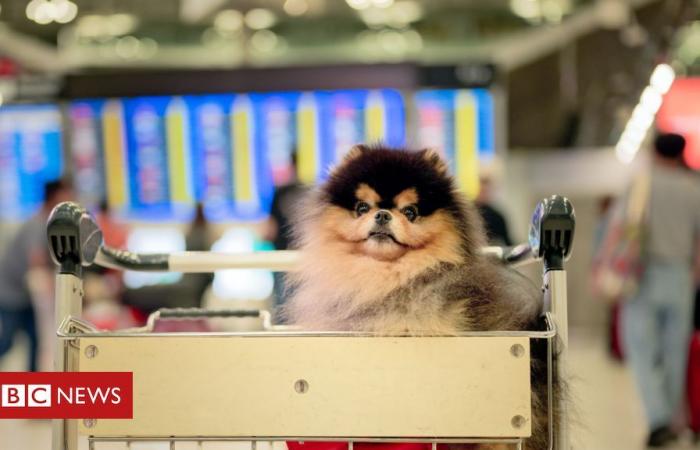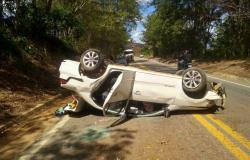- author, Priscila Carvalho
- Roll, From Rio de Janeiro to BBC News Brasil
-
April 24, 2024
After the death of a golden retriever dog on Monday (22/4) on a GOL airline flight, concerns about traveling with pets gained prominence in the news and on social media.
The dog died after a failure in air transport by the company Gollog, which belongs to the company.
The pet, known as Joca, was supposed to leave Guarulhos International Airport, in São Paulo, towards Sinop, in Mato Grosso, where his guardian was waiting for him.
However, the animal ended up in Fortaleza, Ceará.
When he returned to São Paulo, Joca arrived there lifeless, still in the transport box. His trip, which originally should have lasted 2h30, ended up taking 8h.
Videos circulating on social media show its owners complaining about the lack of assistance and a lack of veterinary service at the institution that would check whether or not the dog was fit to take a new flight.
In the footage, the owner’s mother claims that the animal spent a long time in a kennel on the track and exposed to the sun.
The dog’s death has once again brought debate about how airlines should transport pets.
Due to what happened, GOL Linhas Aéreas informed, through an official statement, that it will suspend the sale of the pet transport service for 30 days, for trips carried out in the hold of aircraft, until the investigations are concluded.
GOL also informed in a note that it sympathizes with the suffering of the golden’s owner and his family. He also reported that, due to an operational failure, the animal was boarded on a flight to Fortaleza.
The company also said that it is offering all the necessary support to the tutor and his family from the outset. The investigation of the details of what happened is being carried out with full priority by the company.
The institution also suspended, as of this Wednesday, the sale of the dog and cat transportation service by GOLLOG Animals and the Dog&Cat + Espaço product, for trips carried out in the aircraft’s hold. The Dog&Cat Cabin service, for customers who take their pets in the plane cabin, will not undergo any changes.
“For customers who contracted the transportation of their pet between 04/24/24 and 05/23/24 through services that are restricted, they may opt for a full refund, including the value of their ticket (in the case of Dog&Cat + Espaço), or by postponing the trip, free of charge, until after 05/23/24 on flights until 12/31/2024”, informs the statement.
The report also says that those who are at the destination of their trip and have one of the restricted services contracted for their return will be assisted if they wish.
Finally, in case of doubts, the passenger can contact the company’s customer service by telephone.
Preparation before the trip
In the case of traveling with pets, care begins at home. According to Stephanie Passos, professor of veterinary medicine at Centro Universitário Newton Paiva, in Belo Horizonte (MG), it is necessary to adapt that pet to longer distances and possible changes in routine.
To ensure the safety and well-being of animals during air transport, it is essential to follow the specific recommendations of each airline. In most of them, for example, it is necessary for the animal to be able to move freely, performing a 360° turn inside the transport box.
“Ideally, the animal should already have contact with the box at least 15 days before the trip. It is essential that the owner pleases the animal with snacks, leaves the box open and that the animal sleeps inside”, highlights Paiva .
The compartment must be well closed and the animal must be able to relieve itself appropriately.
“These boxes must have support for water and food. Care is taken to ensure that the dog reaches its destination and, depending on travel time, that it leaves the box as soon as possible so that it can do its physiological needs”, reinforces Álvaro Inácio Lima, veterinarian, specialized in clinic and surgery of dogs and cats from Udesc (University of the State of Santa Catarina).
The use of tranquilizers, according to experts, is not recommended, as it can worsen the animal’s condition in stressful situations, such as air travel.
“If the dog is sedated or takes tranquilizers, it may have some side effects. Even opposite effects. It may become more agitated or may have respiratory depression and also die,” says Paiva.
Veterinarians also advise that, in cases of shorter journeys that can be made within the national territory, opting for land transport is the best option, as it is possible to take breaks and have supervision of the animal.
Rules for transporting animals
The rules for transporting animals in aircraft holds vary depending on the airline, the size, breed of the animal and the destination of the trip.
There are companies operating in Brazil that do not transport large animals in the hold, however, they do not offer any other option to the owner.
“The ideal would be to improve the quality of service provided and not restrict it. The animal is a member of the family and is part of the social circle”, says Paiva.
The solution, according to her, would be to create strategies and specific places on planes for animals to travel with their owners. “They need to be transported in dignified conditions. You can think about creating barriers, putting up something noise-reducing, glass. There are ways,” she says.
It is important to check the rules of the chosen company in advance to ensure that the animal meets all requirements. Consultations can be made on the website or by telephone of each institution.
Furthermore, it is essential that the pet is in good health and is used to traveling to avoid stress during travel.
Before embarking for a destination, the owner must also obtain an Animal Transport Guide (GTA) from a veterinarian, up to seven days in advance of the trip, containing information about the animal, such as microchip, vaccinations and exams carried out.
Animal owner’s rights
Experts interviewed by the report highlight that transporting animals by airlines is not an obligation, but a choice that companies make.
Fernando Eberlin, professor of consumer law at FGV São Paulo, emphasizes that companies are free to determine tariffs and contractual conditions when offering this service.
However, he emphasizes that, when providing this resource, there is a legitimate expectation that it is safe and adequate, in accordance with the principles of the Consumer Protection Code.
“When incidents occur, it is necessary to investigate the cause, and if it is an operational error, the failure to provide services becomes evident, which may result in compensation”, says Eberlin.
For possible compensation, the guardian can request compensation from the airline itself for administrative actions. If he wants greater compensation, he can still seek justice.
“Although it is impossible to measure a value for this type of loss, the claim for compensation will have both a material nature, referring to the actual value of the animal, and a moral one, relating to the suffering and anguish caused by the damaging event”, explains Alexandre Negromonte , lawyer specializing in the consumer area and professor at the Centro Universitário dos Guararapes (UNIFG), in Pernambuco.
To prove the damage suffered, the animal owner must request a report from a responsible veterinarian, in addition to producing footage and photos of the incident.
Regarding complaints to bodies such as Procon and Anac (National Civil Aviation Agency), lawyers highlight that these bodies have investigative powers and can impose penalties, but cannot automatically guarantee the payment of compensation.






